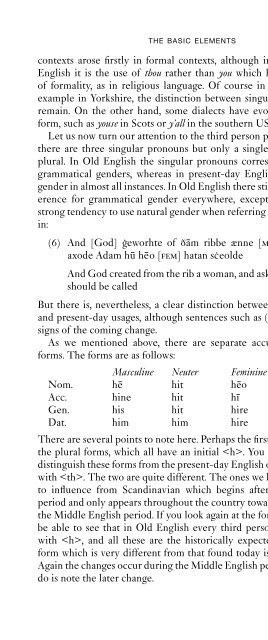An Introduction to Old English
An Introduction to Old English
An Introduction to Old English
Create successful ePaper yourself
Turn your PDF publications into a flip-book with our unique Google optimized e-Paper software.
VERB FORMS 51importantly, before it disappears it causes i-mutation in the comparedforms of the relevant adjective. A typical example of this is eald ‘old’ withcompared forms yldra, yldest. Other similar adjectives are: feorr ‘far’, grēat‘great’, and sc . eort ‘short’, whilst lang ‘long’ and strang ‘strong’ differ onlyin having e as the mutation vowel, e.g. lengra, although if you refer back<strong>to</strong> the previous section you will see that that is <strong>to</strong> be expected, whilstg . eong ‘young’ has g . ingra, g . ing . est. Two further adjectives, brāda ‘broad’ andhēah ‘high’, have both mutated forms and the normal comparison as inblinda, whilst nēah ‘near’ has an unmutated comparative and a mutatedsuperlative.The type of variation seen in those last three words quite probablyindicate that these i-mutated forms were always in competition with theunmutated regular variety, and this suggestion is supported by the factthat in present-day <strong>English</strong> they have all lost their mutated forms withthe exception of elder, eldest alongside older, oldest. But even then themutated forms are of restricted usage.The second group is smaller, but contains items of the highestfrequency. I have not mentioned these previously because their sharedfeature is suppletion. There are only four words here, which split in<strong>to</strong>two semantic groups. The first of these comprises the words gōd ‘good’and yfel ‘evil, bad’; the second consists of lytel ‘little’ and mic . el ‘large’. Theparadigm each is as follows:gōd betra ~ sēlra betst ~ sēlestyfel wyrsa wyrstlytel lǣssa lǣstmiċel māra mǣstNote that in the case of gōd there is not one set of suppletive forms buttwo. There is no distinction <strong>to</strong> be made between them. When the equivalentadverbs, well, yfle, lyt and mic . le, are used they also have suppletiveforms.ExerciseThe following passage is taken from Bede’s account of Cædmon, oftencalled the first <strong>English</strong> poet. Bede was a monk writing at the beginningof the eighth century and based in northern County Durham. Hisgreatest work was the His<strong>to</strong>ria Ecclesiastica Gentis <strong>An</strong>glorum or ‘TheEcclesiastical His<strong>to</strong>ry of the <strong>English</strong> People’. Bede has the best claim<strong>to</strong> be the first systematic his<strong>to</strong>rian of Britain and, without chauvinism, itcan be claimed that in the first half of the eighth century Northumbriawas the intellectual centre of Western Europe.
















